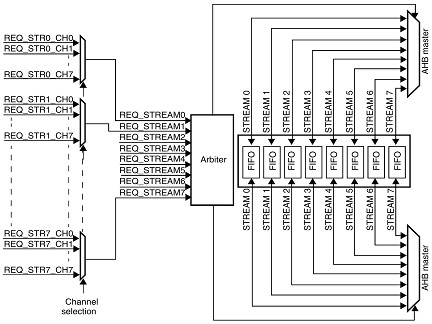Copy memory on STM32
Interesting results of different ways of copying memory:
STM32F411RE 96 MHz
Initialize src 27422 kB/s
for i := range src { dst[i] = src[i] } 17330 kB/s
copy(dst, src) 38367 kB/s
DMA 121004 kB/s
DMA FT1 122148 kB/s
DMA FT2 122086 kB/s
DMA FT3 121303 kB/s
DMA FT4 98422 kB/s
DMA FT4 PB4 MB4 122543 kB/s
STM32F407VG 168 MHz
Initialize src 47989 kB/s
for i := range src { dst[i] = src[i] } 29798 kB/s
copy(dst, src) 64153 kB/s
DMA 162141 kB/s
DMA FT1 162325 kB/s
DMA FT2 161654 kB/s
DMA FT3 161897 kB/s
DMA FT4 138937 kB/s
DMA FT4 PB4 MB4 187397 kB/s
The src and dst are both of type []uint32.
Initialize src is simple:
for i := range src {
src[i] = uint32(i)
}
for i := range src { dst[i] = src[i] } doesn’t require explanation.
copy(dst, src) uses builtin copy function that is implemented in assembly.
DMA uses DMA peripheral in direct mode (FIFO not used).
DMA FT1 uses DMA with internal 4-word FIFO enabled. Memory write is trigered immediately when FIFO is filled in 1/4 (one word).
DMA FT2 also uses DMA in FIFO mode. Memory write triggered when FIFO filled in 2/4 (two words).
DMA FT3 - memory write triggered at 3/4 (three words).
DMA FT4 - memory write triggered when FIFO is full.
DMA FT4 PB4 MB4 uses DMA in 4-word burst mode.
As you can see DMA is ca. three times faster than copy (but only copy handles correctly any overlapping src and dst).
You can also see that it’s not good to wait for write until the FIFO is full.
The best performance is achieved using AHB burst mode. There is a warning about burst transfers:
The burst configuration has to be selected in order to respect the AHB protocol, where bursts must not cross the 1 KB address boundary because the minimum address space that can be allocated to a single slave is 1 KB. This means that the 1 KB address boundary should not be crossed by a burst block transfer, otherwise an AHB error would be generated, that is not reported by the DMA registers.
I don’t quite understand this warning but despite the deliberate attempts to generate this error it doesn’t occur in case of memory to memory transfer.
